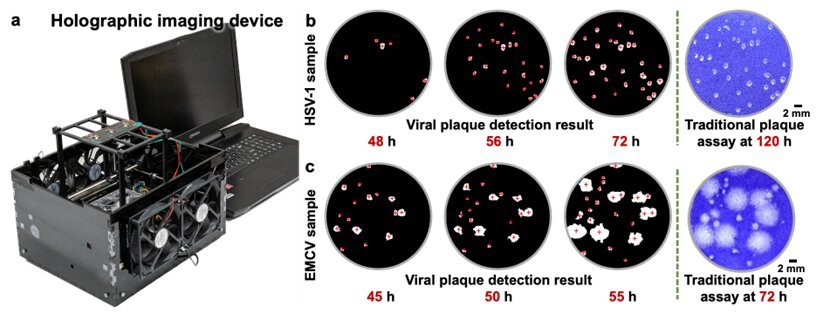Humanity has faced the challenge of viral infections for centuries. Despite scientific advancements, the struggle against viruses persists, as evidenced by the recent COVID-19 pandemic. Detecting and quantifying viruses is crucial for the development of vaccines and antiviral medications, and the viral plaque assay has emerged as the gold standard technique. However, traditional plaque assays are time-consuming and prone to errors.
In a recent publication in Nature Biomedical Engineering, Professor Aydogan Ozcan and his team from UCLA presented a breakthrough in viral plaque detection. They developed a rapid, automated, and stain-free system that combines holography and deep learning. This system utilizes a cost-effective holographic imaging device to continuously monitor virus-infected cells during incubation. AI algorithms analyze time-lapse holograms to detect and count viral plaques automatically.
The researchers successfully demonstrated the effectiveness of this system using three viruses: vesicular stomatitis virus (VSV), herpes simplex virus type-1 (HSV-1), and encephalomyocarditis virus (EMCV). With this system, they achieved over 90% detection of VSV viral plaques within 20 hours, eliminating the need for chemical staining and reducing the detection time by more than 24 hours compared to traditional assays. For HSV-1 and EMCV, the system reduced detection times by approximately 48 and 20 hours, respectively.
Notably, this stain-free system can identify individual viral plaques within clusters, overcoming limitations of traditional assays. By significantly reducing detection time and eliminating staining and manual counting, this AI-powered viral plaque detection system has the potential to accelerate vaccine and drug development research in virology.
Overall, this groundbreaking technology offers a promising solution to the challenges posed by traditional viral plaque assays, providing a rapid, accurate, and cost-effective approach to virus detection and quantification.
Source: UCLA Engineering Institute for Technology Advancement
